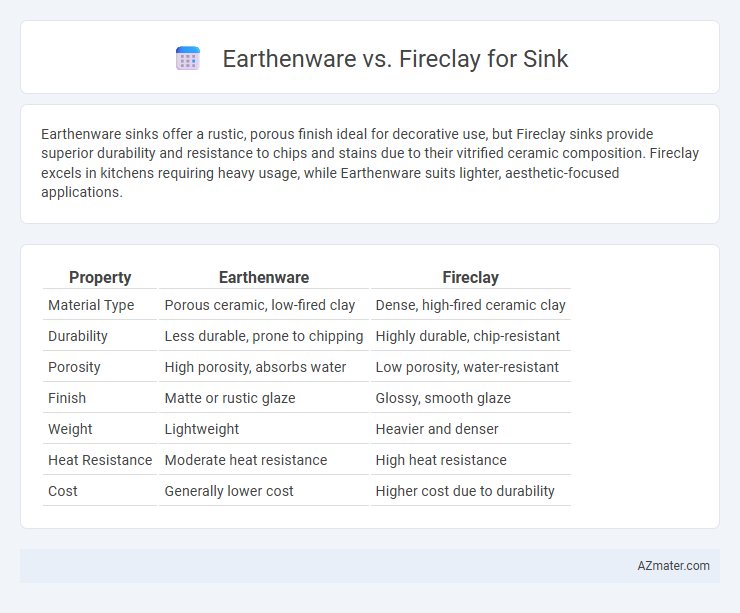Earthenware sinks offer a rustic, porous finish ideal for decorative use, but Fireclay sinks provide superior durability and resistance to chips and stains due to their vitrified ceramic composition. Fireclay excels in kitchens requiring heavy usage, while Earthenware suits lighter, aesthetic-focused applications.
Table of Comparison
| Property | Earthenware | Fireclay |
|---|---|---|
| Material Type | Porous ceramic, low-fired clay | Dense, high-fired ceramic clay |
| Durability | Less durable, prone to chipping | Highly durable, chip-resistant |
| Porosity | High porosity, absorbs water | Low porosity, water-resistant |
| Finish | Matte or rustic glaze | Glossy, smooth glaze |
| Weight | Lightweight | Heavier and denser |
| Heat Resistance | Moderate heat resistance | High heat resistance |
| Cost | Generally lower cost | Higher cost due to durability |
Overview: Understanding Earthenware and Fireclay Sinks
Earthenware sinks are made from natural clay fired at lower temperatures, resulting in a porous, softer material that requires glazing for durability and stain resistance. Fireclay sinks, crafted from refined clay fired at higher temperatures, offer a denser, non-porous surface that is highly resistant to chips, scratches, and thermal shock. Both materials provide unique aesthetic and functional qualities, with fireclay sinks typically favored for their superior strength and long-lasting finish in kitchen and bathroom applications.
Material Composition: What Sets Earthenware and Fireclay Apart
Earthenware sinks consist primarily of natural clay fired at lower temperatures, resulting in a porous, softer material often coated with a glaze for durability. Fireclay sinks are made from a mixture of refined clay and flint, fired at extremely high temperatures above 1200degC, creating a dense, vitrified surface that is highly resistant to scratches and stains. The key distinction lies in fireclay's superior hardness and non-porous finish compared to the more porous and less durable earthenware.
Durability and Strength Comparison
Earthenware sinks, made from clay fired at lower temperatures, tend to be more porous and less durable compared to fireclay sinks, which are fired at higher temperatures resulting in a denser, stronger material. Fireclay sinks exhibit superior resistance to chipping, cracking, and staining due to their vitrified surface, making them ideal for heavy use in kitchens and bathrooms. While earthenware offers affordability and classic aesthetics, fireclay provides enhanced longevity and strength critical for long-term sink performance.
Resistance to Stains, Scratches, and Chips
Earthenware sinks, made from porous clay materials, tend to be more susceptible to stains and chips due to their relatively softer composition compared to fireclay sinks. Fireclay sinks, crafted from vitrified clay fired at higher temperatures, offer superior resistance to scratches, stains, and chips, making them more durable for heavy kitchen use. The non-porous surface of fireclay provides enhanced protection against discoloration and wear, ensuring long-lasting performance and aesthetic appeal.
Maintenance and Cleaning Requirements
Earthenware sinks require gentle cleaning with non-abrasive, pH-neutral detergents to avoid surface scratches and maintain their glossy finish, as they are more porous and prone to staining. Fireclay sinks, made from vitrified clay and fired at higher temperatures, offer a denser, non-porous surface that resists chips, stains, and bacteria buildup, simplifying maintenance with regular wiping using mild cleaners. Both materials benefit from immediate cleanup of acidic or corrosive substances to preserve durability and appearance over time.
Design, Style, and Color Options
Earthenware sinks offer a wide range of traditional and rustic design styles with warm, earthy color options such as tan, brown, and cream, making them ideal for farmhouse or vintage kitchens. Fireclay sinks provide a smoother, glass-like finish available in bright, glossy colors like white, black, and vibrant blues, complementing modern and contemporary design aesthetics. The durability of fireclay allows for more intricate shapes and sleek lines, while earthenware emphasizes handcrafted charm with slightly softer edges and matte textures.
Installation Differences Between Earthenware and Fireclay
Installation differences between earthenware and fireclay sinks primarily stem from their material properties and weight. Earthenware sinks are generally lighter, making them easier and quicker to handle during installation, while fireclay sinks are denser and heavier, requiring additional support and careful positioning to avoid damage. Fireclay's durability demands professional expertise to securely anchor the sink and ensure long-term stability, whereas earthenware can often be installed with standard fittings and basic support structures.
Cost Analysis: Price Points and Value
Earthenware sinks typically have lower price points ranging from $100 to $400, making them a budget-friendly option for homeowners seeking aesthetic appeal without a high investment. Fireclay sinks, while more expensive with costs between $400 and $1,200, offer superior durability, scratch resistance, and a longer lifespan that can justify the higher upfront expense. Evaluating cost versus value, fireclay's robustness tends to reduce maintenance and replacement costs, providing better long-term financial benefits despite the initial premium price.
Environmental Impact and Sustainability
Earthenware sinks, made from natural clay fired at lower temperatures, consume less energy and have a smaller carbon footprint compared to fireclay sinks, which require higher firing temperatures for enhanced durability. The sourcing of earthenware materials often involves less intensive mining processes, promoting better soil conservation and reduced habitat disruption. Fireclay sinks, although more durable and longer-lasting, incur a greater environmental impact due to their energy-intensive production but offer sustainability benefits through longevity and reduced replacement frequency.
Choosing the Right Sink: Key Considerations for Homeowners
Earthenware sinks offer a classic, affordable option with a smooth glaze but tend to be more porous and less durable than fireclay, which boasts superior strength, heat resistance, and chip resistance due to its dense ceramic composition. Homeowners prioritizing longevity and heavy use often prefer fireclay sinks, which maintain their glossy finish and resist staining better over time. Budget constraints and aesthetic preferences are key factors when choosing between earthenware's traditional look and fireclay's robust performance for kitchen or bathroom installations.

Infographic: Earthenware vs Fireclay for Sink
 azmater.com
azmater.com